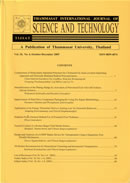ThaiScience
ThaiScience
THAMMASAT INTERNATIONAL JOURNAL OF SCIENCE & TECHNOLOGY
Volume 25, No. 03, Month JULY, Year 2020, Pages 127 - 130
The effects of stress conditions on antibacterial activities of zanthoxylum rhetsa fruit extract
Nawatpong Chairat, Arunporn Itharat
Abstract Download PDF
Zanthoxylum rhetsa (Ma-kwaen) fruit is widely distributed in the northern part of Thailand. It is used for food flavoring and treating diseases of the oral cavity by folk doctors in the same manner as an antibiotic. In our previous study, 50% ethanolic extract of Z. rhetsa fruit exhibited antibacterial activities against oral pathogens Streptococcus mutans, Streptococcus pyogenes, and Staphylococcus aureus. The aim of this study was to investigate the effects of degradative stress conditions (thermolysis, hydrolysis, acid hydrolysis, alkaline hydrolysis, and oxidation) on Z. rhetsa antibacterial activity, in order to obtain relevant data on the extract before product formulation. The extract was treated with H2O, 3N HCl, 3N NaOH, 30% H2O2 and heated to 80°C on a water bath for 3 hours. All extracts were tested for antibacterial activity by the determination of minimal inhibitory concentration (MIC). The extract, which had gone through thermolysis, hydrolysis, and oxidation, as well as the control, showed antibacterial activities against S. mutans, S. pyogenes and S. aureus with the same MIC values of 0.078, 0.156, and 0.313 mg/mL, respectively. The acid-hydrolysed extract showed MIC values of 1.25, 0.625, and 2.5 mg/mL and the alkaline-hydrolysed extract showed MIC values of 0.313, 0.625, and 0.625 mg/mL, respectively. These results indicated that acid and alkaline hydrolyses lowered the extract’s antibacterial activity. Therefore, pH should be considered when Ma-kwaen extract preparation is formulated, i.e. it should be adjusted to neutral to maintain its antibacterial activity.
Keywords
Stress test, Antibacterial activity, Zanthoxylum rhetsa fruit extract, Ma-kwaenTHAMMASAT INTERNATIONAL JOURNAL OF SCIENCE & TECHNOLOGY
Published by : Thammasat University
Contributions welcome at : http://www.tijsat.tu.ac.th
